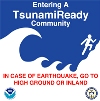
Five Years After Indonesian Tsunami, Readiness Improved
The National Oceanic and Atmospheric Administration says it received $225 million since that Dec. 26, 2004, disaster for expanded detection and warning systems, research, community education, and a global warning network and technology transfer program.
Dec. 26, 2004, was the date of the Indonesian tsunami that killed 230,000 people. Lack of an effective international warning system contributed to that death toll, according to the Commerce Department's National Oceanic and Atmospheric Administration (NOAA). NOAA has received $225 million since that 2004, disaster for expanded detection and warning systems, research, community education, and a global warning network and technology transfer program.
All of these are vital survival tools because what matters during a tsunami is people's ability to receive warnings and quickly move inland or to higher ground.
"NOAA is advancing tsunami science and warning systems for America and many at-risk parts of the world," said Jane Lubchenco, Ph.D., under secretary of commerce for oceans and atmosphere and NOAA's administrator. "Our efforts cannot stop with researching, developing technology, and issuing forecasts. Successful early warning ultimately relies on communicating the threat clearly so a prepared population will be able to act responsibly."
The money has better prepared both the United States and the rest of the world for the next big tsunami, according to NOAA. In 2004, 11 U.S. communities were prepared for a tsunami through the TsunamiReady program, but now 72 communities are considered ready. And while five states were members of the National Tsunami Hazard Mitigation Program five years ago, 29 states, territories, and commonwealths now participate. The two U.S. tsunami warning centers were staffed eight hours a day, five days per week with on-call coverage back then, but they're staffed 24/7/365 today and responsible for all Indian Ocean and Caribbean nations and all U.S. and Canadian coastlines.
"NOAA has strong capabilities to detect tsunamis and issue warnings, but at the end of the day, we need people to pay attention to these warnings and immediately move to high ground to save their own lives," said Jenifer Rhoades, tsunami program manager at NOAA's National Weather Service. "A violent or persistent ground shake is nature's warning. Don't wait to take action. This knowledge can save countless lives, as it did when the recent tsunami struck American and Independent Samoa."